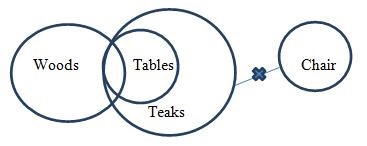Question
Statements: Some woods are tables. All
tables are teaks. No teak is a chair. Conclusions: I. Some woods are teaks. II. Some woods are not chairs. III. Some tables are not chairs. In each question below are given three statements followed by three conclusions numbered I, II and III. You have to take the two given statements to be true even if they seem to be at variance with commonly known facts and then decide which of the given conclusions logically follows from the two given statements, disregarding commonly known facts.Solution
Some woods are tables (I) + All tables are teaks (A) ⇒ Some woods are teaks (I) + No teak is a chair(E) ⇒ Some woods are not chairs(O) . Hence, conclusion I and II follows. All tables are teaks(A) + No teak is a chair(E) ⇒ No table is a chair(E) ⇒ Conversion ⇒ Some tables are not chairs(O). Hence, conclusion III follows. Alternate Method: Minimum possibility: 
How important is it for you to have a clear plan or goal in mind?
What steps do you take when your values or beliefs clash with those of your company or organisation?
How likely are you to prioritize the needs of others over your own needs?
How do you approach working in a team environment?
How likely are you to try new things or explore new ideas?
How do you approach new challenges?
How important is it for you to have a sense of control in your life?
How often do you feel comfortable speaking in front of a large group of people?
How do you handle situations where your values or beliefs conflict with those of your employer or organization?
How do you approach circumstances in which you must cooperate with people whose personalities clash with your own?


